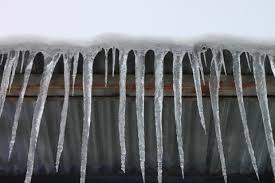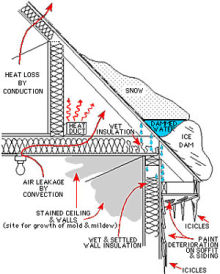Watch the REAL science behind those pesky ice dams. Watch this amazing video to learn where you are losing energy and where you’ll get your ice problems.
Ice dams are not always natural occurrences caused by freezing weather. Ice dams are the cause of interior heat loss known as thermal or air bypass to attic spaces that permit micro-melts or uneven snow melts that freeze at the cold gutter, soffit, or overhang locations. Basement negative pressure and upper floor thermal bypass corrections usually minimize the ice dam phenomenon. Ice guard, gutter melting cords, and gutter caps contraptions are only bandages.
What is an ice dam?

An ice dam is a ridge of ice that forms at the edge of a roof and prevents melting snow (water) from draining off the roof. The water that backs up behind the dam can leak into a home and cause damage to walls, ceilings, insulation, and other areas. Figure 1 (below) shows a cross section of a home with an ice dam.
What causes ice dams?
There is a complex interaction among the amount of heat loss from a house, snow cover, and outside temperatures that leads to ice dam formation. For ice dams to form there must be snow on the roof, and, at the same time, higher portions of the roof’s outside surface must be above 32°F while lower surfaces are below 32°F. For a portion of the roof to be below 32°F, outside temperatures must also be below 32°F. When we say temperatures above or below 32°F, we are talking about average temperature over sustained periods of time.

Figure 1. Cross section of a one-and-a-half story house with an ice dam.
The snow on a roof surface that is above 32°F will melt. As water flows down the roof it reaches the portion of the roof that is below 32°F and freezes. Voila! – an ice dam.
The dam grows as it is fed by the melting snow above it, but it will limit itself to the portions of the roof that are on the average below 32°F. So the water above backs up behind the ice dam and remains a liquid. This water finds cracks and openings in the exterior roof covering and flows into the attic space. From the attic it could flow into exterior walls or through the ceiling insulation and stain the ceiling finish.
Immediate action:
- Remove snow from the roof. This eliminates one of the ingredients necessary for the formation of an ice dam. A “roof rake” and push broom can be used to remove snow, but may damage the roofing materials.
- In an emergency situation where water is flowing into the house structure, making channels through the ice dam allows the water behind the dam to drain off the roof. Hosing with tap water on a warm day will do this job. Work upward from the lower edge of the dam. The channel will become ineffective within days and is only a temporary solution to ice dam damage.
Precautions
There are precautions you can take to minimize the chances that your home will be damaged when the snow starts falling.
As the ice dam builds, the water from the melting snow begins to pool behind it and can eventually work up under the shingles and enter the attic, causing damage to the roof, ceilings, walls and contents of the house or apartment. When the ceiling insulation becomes wet, it loses its insulation value, which can make the attic even warmer and make the ice dam condition worse. Proper ventilation helps keep the attic cool and may help avoid ice dams.
Generally speaking, if your home was built before 1970 and has not had the attic insulation R-Value upgraded or the attic ventilation improved, your roof may well be a candidate for the formation of ice dams. Your goal is to create a cool, dry underside of the roof deck, so as to discourage the rapid melting of snow on the roof. Good airflow from under the eaves or soffit area, along the underside of the roof, and out through roof vents will help accomplish this. Ridge vents need to be kept open and clear.Tenants of homes or apartments should check with their landlords for details.
Lessen your potential for this type of damage by providing a higher R-Value of insulation in the attic. This will keep your house warmer, the ultimate goal of keeping your attic cooler. Most experts agree that the R-Value of attic insulation should be at least R-30 (R-38 is preferable in northern climates). This increased attic insulation will make your home more energy efficient and also should help lower your heating/cooling costs.
Also, anything that leaks heat into the attic can contribute to the problem. This includes exhaust fan ducts, chimneys, attic hatches and pipe penetrations. Sealing around these can help. Upgrades in both insulation AND ventilation must be made for maximal effectiveness. Consult a reputable roofing and/or insulation contractor and be sure to contact your local building code department for additional information, as well as required permits. Some other options include:
Ice belt
Install metal flashing all the way along the eaves and extend to the area of the roof above the attic. It should cover the area where the ice will form and provide a slippery surface that snow and ice will slide off. It also provides a surface that water won’t flow up under as it does with shingles. There are other membranes that serve the same purpose to keep the water out that can be installed under the shingles at the eaves. Removing the rain gutters is often necessary since they can become a blockage holding the snow and ice at the edge of the roof causing a dam.
A metal roof
These, while expensive, eliminate ice dams completely. The snow and ice will slide right off, and they have no horizontal seam that water can get up under.
Heat tracing
Heat tracing can be run along the eaves. You turn them on if an ice dam begins to form and the heat will melt the snow and ice on the eaves, eliminating the ice dam. It’s relatively easy to install and fairly inexpensive to purchase. It only needs to be run when a dam is forming, so it is not a large energy user.
Roof rakes
Once winter arrives, make every effort to keep the snow load on your roof to a minimum. Long-handled devices called “roof rakes” allow single story homeowners to stand on the ground and pull the snow off the roof. This reduces the chance for ice dam formations as they can go undetected under a snow load. It also reduces the chance of roof failure due to an excessive snow load.
During winter months, make sure gutters and downspouts are kept free of snow and ice buildup and the formation of icicles. Keeping them clear allows a ready path for the melted roof snow to exit the roof, thus eliminating the potential for ice dam formation, and reduces the weight of ice and snow on the gutters and down spouts. Excessive weight can cause these devices to pull away from the house or be otherwise damaged.